Uruguayan vs Yakama Community Comparison
COMPARE
Uruguayan
Yakama
Social Comparison
Social Comparison
Uruguayans
Yakama
4,949
SOCIAL INDEX
47.0/ 100
SOCIAL RATING
188th/ 347
SOCIAL RANK
1,331
SOCIAL INDEX
10.9/ 100
SOCIAL RATING
315th/ 347
SOCIAL RANK
Yakama Integration in Uruguayan Communities
The statistical analysis conducted on geographies consisting of 10,026,917 people shows a perfect positive correlation between the proportion of Yakama within Uruguayan communities in the United States with a correlation coefficient (R) of 1.000. On average, for every 1% (one percent) increase in Uruguayans within a typical geography, there is an increase of 0.380% in Yakama. To illustrate, in a geography comprising of 100,000 individuals, a rise of 1,000 Uruguayans corresponds to an increase of 379.9 Yakama.
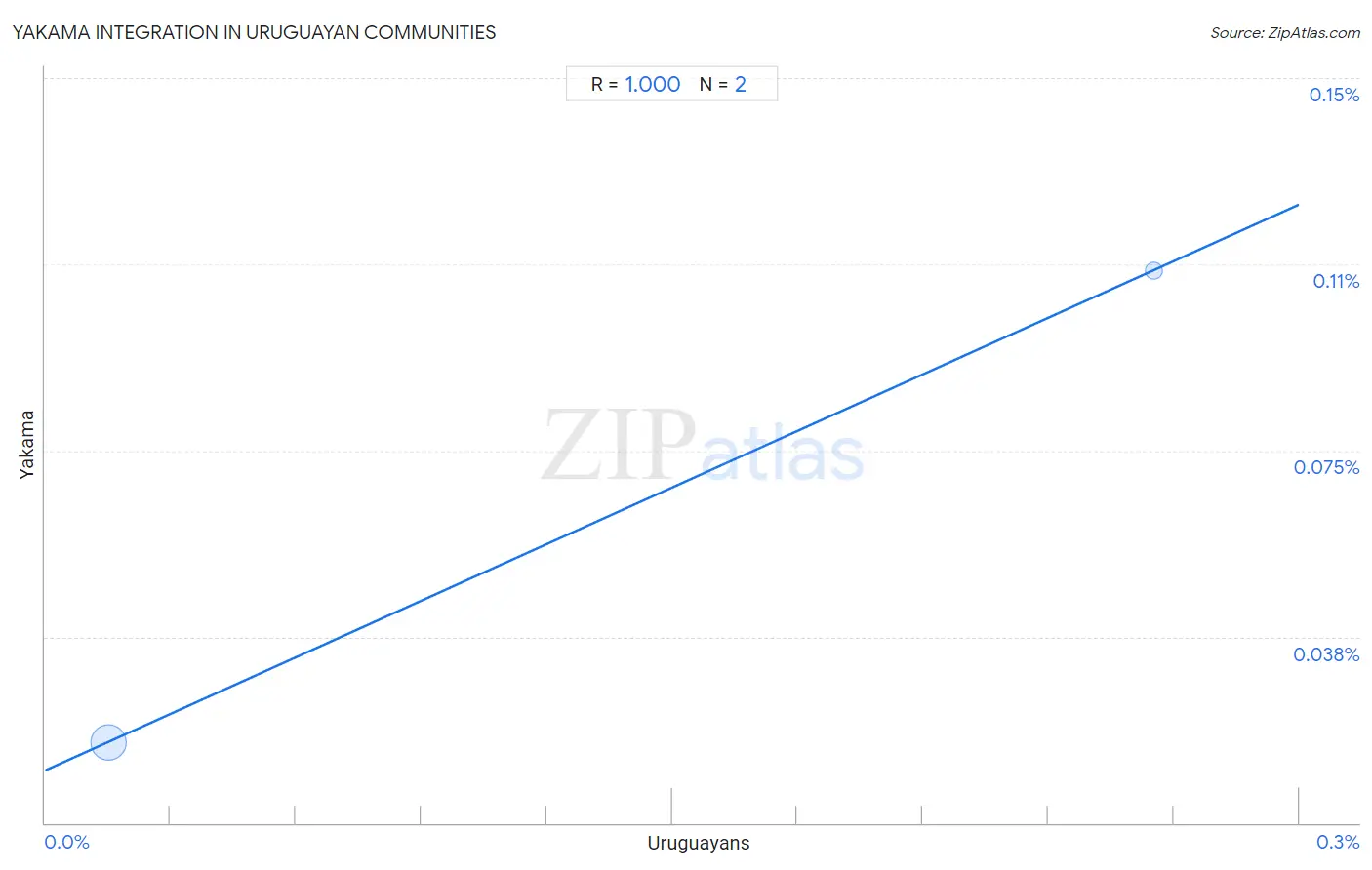
Uruguayan vs Yakama Income
When considering income, the most significant differences between Uruguayan and Yakama communities in the United States are seen in per capita income ($44,318 compared to $33,009, a difference of 34.3%), householder income ages 25 - 44 years ($93,631 compared to $76,226, a difference of 22.8%), and median family income ($100,656 compared to $83,932, a difference of 19.9%). Conversely, both communities are more comparable in terms of householder income under 25 years ($52,465 compared to $54,321, a difference of 3.5%), householder income over 65 years ($59,090 compared to $56,234, a difference of 5.1%), and wage/income gap (25.2% compared to 23.7%, a difference of 5.9%).

| Income Metric | Uruguayan | Yakama |
| Per Capita Income | Good $44,318 | Tragic $33,009 |
| Median Family Income | Fair $100,656 | Tragic $83,932 |
| Median Household Income | Average $84,691 | Tragic $72,225 |
| Median Earnings | Average $46,190 | Tragic $39,107 |
| Median Male Earnings | Fair $53,680 | Tragic $45,002 |
| Median Female Earnings | Fair $39,228 | Tragic $33,354 |
| Householder Age | Under 25 years | Good $52,465 | Exceptional $54,321 |
| Householder Age | 25 - 44 years | Fair $93,631 | Tragic $76,226 |
| Householder Age | 45 - 64 years | Fair $98,660 | Tragic $86,992 |
| Householder Age | Over 65 years | Poor $59,090 | Tragic $56,234 |
| Wage/Income Gap | Excellent 25.2% | Exceptional 23.7% |
Uruguayan vs Yakama Poverty
When considering poverty, the most significant differences between Uruguayan and Yakama communities in the United States are seen in receiving food stamps (11.8% compared to 21.4%, a difference of 81.1%), married-couple family poverty (5.4% compared to 9.0%, a difference of 66.3%), and family poverty (9.1% compared to 13.1%, a difference of 43.3%). Conversely, both communities are more comparable in terms of single father poverty (15.9% compared to 18.1%, a difference of 14.3%), seniors poverty over the age of 65 (12.1% compared to 14.8%, a difference of 22.4%), and single mother poverty (28.3% compared to 36.4%, a difference of 28.5%).
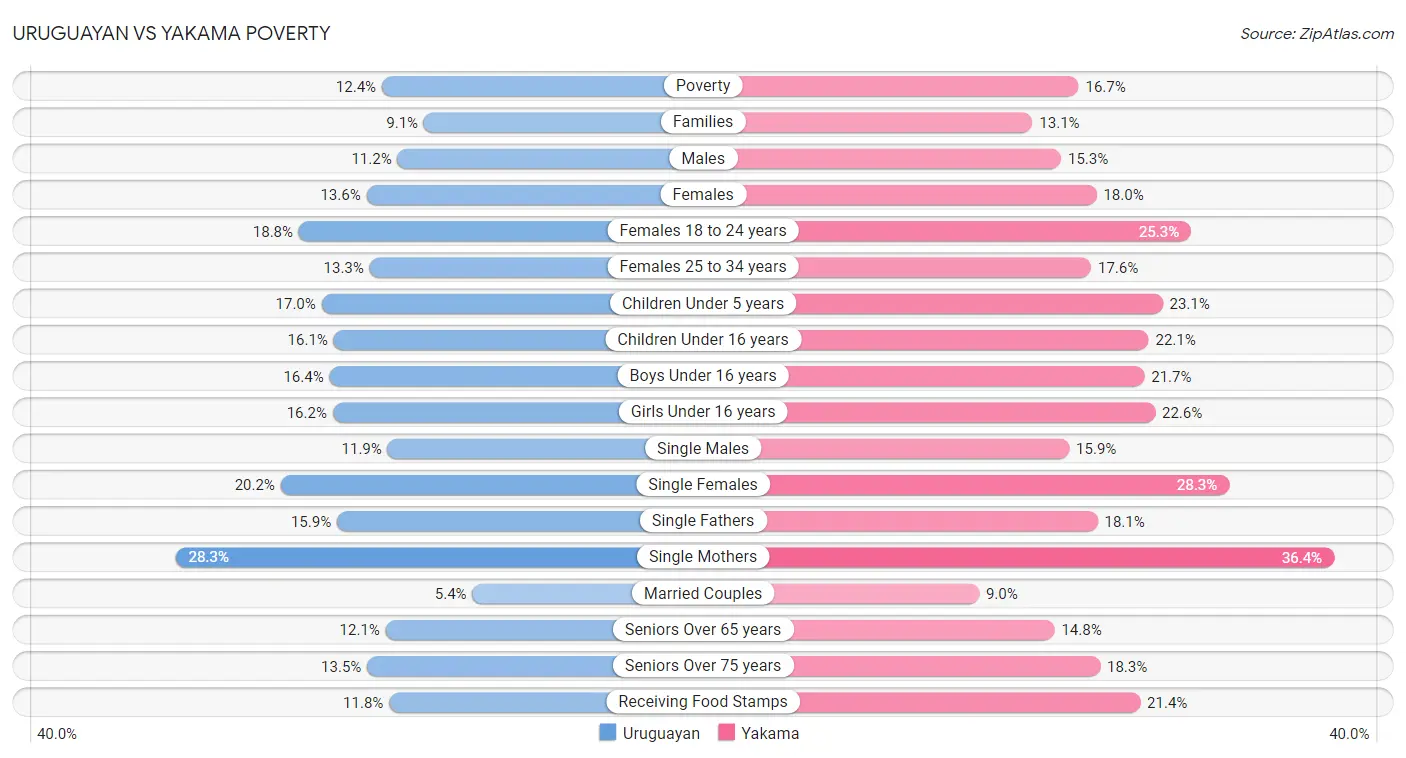
| Poverty Metric | Uruguayan | Yakama |
| Poverty | Average 12.4% | Tragic 16.7% |
| Families | Fair 9.1% | Tragic 13.1% |
| Males | Average 11.2% | Tragic 15.3% |
| Females | Fair 13.6% | Tragic 18.0% |
| Females 18 to 24 years | Exceptional 18.8% | Tragic 25.3% |
| Females 25 to 34 years | Good 13.3% | Tragic 17.6% |
| Children Under 5 years | Good 17.0% | Tragic 23.1% |
| Children Under 16 years | Average 16.1% | Tragic 22.1% |
| Boys Under 16 years | Average 16.4% | Tragic 21.7% |
| Girls Under 16 years | Good 16.2% | Tragic 22.6% |
| Single Males | Exceptional 11.9% | Tragic 15.9% |
| Single Females | Exceptional 20.2% | Tragic 28.3% |
| Single Fathers | Exceptional 15.9% | Tragic 18.1% |
| Single Mothers | Exceptional 28.3% | Tragic 36.4% |
| Married Couples | Fair 5.4% | Tragic 9.0% |
| Seniors Over 65 years | Tragic 12.1% | Tragic 14.8% |
| Seniors Over 75 years | Tragic 13.5% | Tragic 18.3% |
| Receiving Food Stamps | Average 11.8% | Tragic 21.4% |
Uruguayan vs Yakama Unemployment
When considering unemployment, the most significant differences between Uruguayan and Yakama communities in the United States are seen in unemployment among seniors over 75 years (7.9% compared to 18.4%, a difference of 132.5%), unemployment among ages 30 to 34 years (5.2% compared to 9.8%, a difference of 88.7%), and unemployment among ages 55 to 59 years (4.8% compared to 8.9%, a difference of 85.8%). Conversely, both communities are more comparable in terms of unemployment among women with children ages 6 to 17 years (9.3% compared to 9.9%, a difference of 6.2%), unemployment among women with children under 6 years (7.5% compared to 6.6%, a difference of 13.3%), and unemployment among ages 35 to 44 years (4.8% compared to 5.6%, a difference of 17.3%).
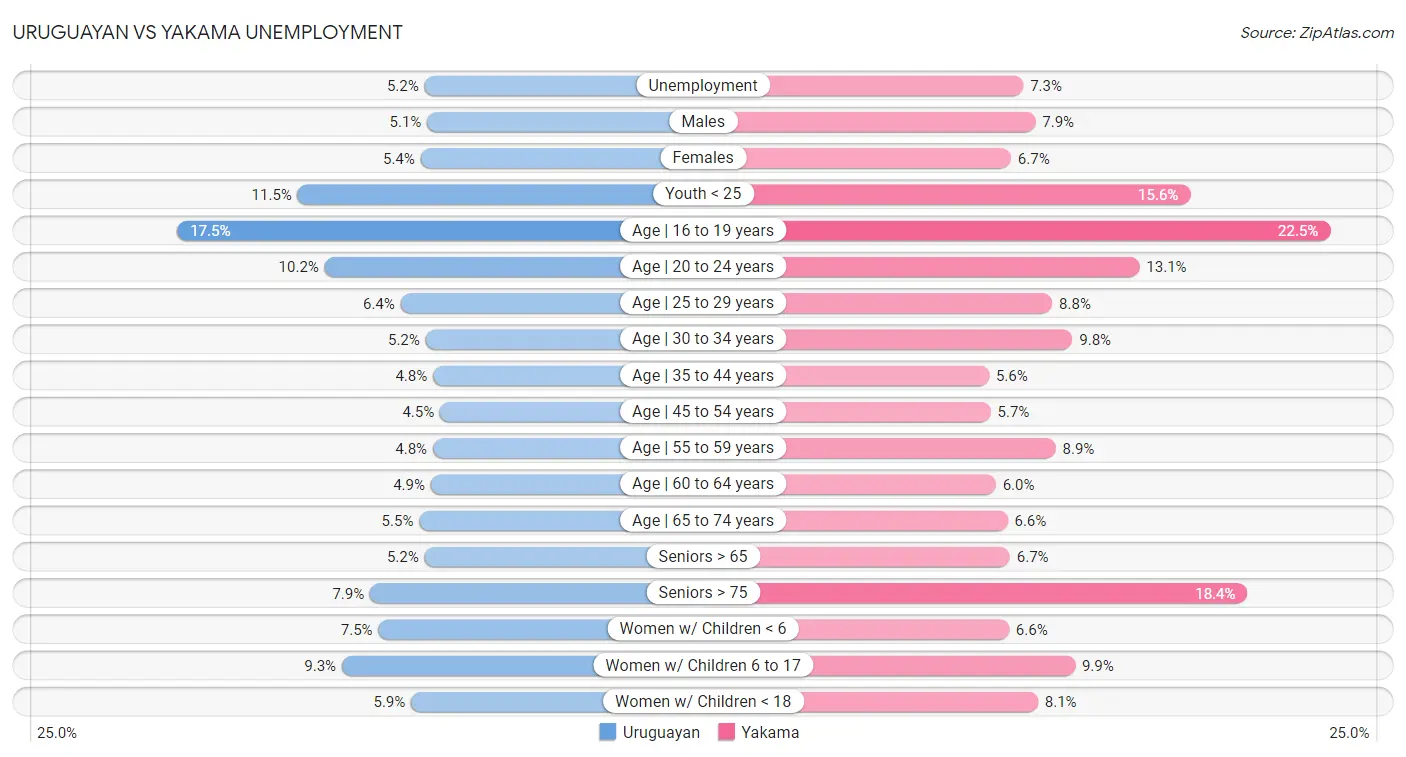
| Unemployment Metric | Uruguayan | Yakama |
| Unemployment | Good 5.2% | Tragic 7.3% |
| Males | Exceptional 5.1% | Tragic 7.9% |
| Females | Poor 5.4% | Tragic 6.7% |
| Youth < 25 | Good 11.5% | Tragic 15.6% |
| Age | 16 to 19 years | Good 17.5% | Tragic 22.5% |
| Age | 20 to 24 years | Excellent 10.2% | Tragic 13.1% |
| Age | 25 to 29 years | Exceptional 6.4% | Tragic 8.8% |
| Age | 30 to 34 years | Exceptional 5.2% | Tragic 9.8% |
| Age | 35 to 44 years | Fair 4.8% | Tragic 5.6% |
| Age | 45 to 54 years | Good 4.5% | Tragic 5.7% |
| Age | 55 to 59 years | Average 4.8% | Tragic 8.9% |
| Age | 60 to 64 years | Poor 4.9% | Tragic 6.0% |
| Age | 65 to 74 years | Tragic 5.5% | Tragic 6.6% |
| Seniors > 65 | Poor 5.2% | Tragic 6.7% |
| Seniors > 75 | Exceptional 7.9% | Tragic 18.4% |
| Women w/ Children < 6 | Good 7.5% | Exceptional 6.6% |
| Women w/ Children 6 to 17 | Tragic 9.3% | Tragic 9.9% |
| Women w/ Children < 18 | Tragic 5.9% | Tragic 8.1% |
Uruguayan vs Yakama Labor Participation
When considering labor participation, the most significant differences between Uruguayan and Yakama communities in the United States are seen in in labor force | age 35-44 (84.7% compared to 79.0%, a difference of 7.3%), in labor force | age 30-34 (84.9% compared to 79.1%, a difference of 7.3%), and in labor force | age > 16 (65.9% compared to 62.1%, a difference of 6.0%). Conversely, both communities are more comparable in terms of in labor force | age 20-24 (74.6% compared to 75.1%, a difference of 0.65%), in labor force | age 45-54 (83.1% compared to 80.6%, a difference of 3.2%), and in labor force | age 25-29 (84.9% compared to 80.6%, a difference of 5.4%).

| Labor Participation Metric | Uruguayan | Yakama |
| In Labor Force | Age > 16 | Exceptional 65.9% | Tragic 62.1% |
| In Labor Force | Age 20-64 | Exceptional 80.1% | Tragic 75.8% |
| In Labor Force | Age 16-19 | Tragic 34.9% | Good 36.9% |
| In Labor Force | Age 20-24 | Poor 74.6% | Average 75.1% |
| In Labor Force | Age 25-29 | Excellent 84.9% | Tragic 80.6% |
| In Labor Force | Age 30-34 | Good 84.9% | Tragic 79.1% |
| In Labor Force | Age 35-44 | Exceptional 84.7% | Tragic 79.0% |
| In Labor Force | Age 45-54 | Excellent 83.1% | Tragic 80.6% |
Uruguayan vs Yakama Family Structure
When considering family structure, the most significant differences between Uruguayan and Yakama communities in the United States are seen in single father households (2.4% compared to 4.2%, a difference of 76.2%), single mother households (6.6% compared to 8.4%, a difference of 28.0%), and births to unmarried women (33.1% compared to 40.3%, a difference of 21.8%). Conversely, both communities are more comparable in terms of married-couple households (45.5% compared to 45.2%, a difference of 0.61%), divorced or separated (12.4% compared to 12.3%, a difference of 0.75%), and currently married (45.6% compared to 44.0%, a difference of 3.6%).

| Family Structure Metric | Uruguayan | Yakama |
| Family Households | Good 64.5% | Exceptional 69.3% |
| Family Households with Children | Excellent 27.7% | Exceptional 30.8% |
| Married-couple Households | Poor 45.5% | Tragic 45.2% |
| Average Family Size | Average 3.23 | Exceptional 3.45 |
| Single Father Households | Fair 2.4% | Tragic 4.2% |
| Single Mother Households | Poor 6.6% | Tragic 8.4% |
| Currently Married | Tragic 45.6% | Tragic 44.0% |
| Divorced or Separated | Tragic 12.4% | Tragic 12.3% |
| Births to Unmarried Women | Poor 33.1% | Tragic 40.3% |
Uruguayan vs Yakama Vehicle Availability
When considering vehicle availability, the most significant differences between Uruguayan and Yakama communities in the United States are seen in 4 or more vehicles in household (5.6% compared to 12.9%, a difference of 129.8%), 3 or more vehicles in household (17.8% compared to 31.0%, a difference of 74.0%), and no vehicles in household (11.3% compared to 6.6%, a difference of 70.7%). Conversely, both communities are more comparable in terms of 1 or more vehicles in household (88.8% compared to 93.6%, a difference of 5.4%), 2 or more vehicles in household (52.7% compared to 64.9%, a difference of 23.3%), and no vehicles in household (11.3% compared to 6.6%, a difference of 70.7%).

| Vehicle Availability Metric | Uruguayan | Yakama |
| No Vehicles Available | Tragic 11.3% | Exceptional 6.6% |
| 1+ Vehicles Available | Tragic 88.8% | Exceptional 93.6% |
| 2+ Vehicles Available | Tragic 52.7% | Exceptional 64.9% |
| 3+ Vehicles Available | Tragic 17.8% | Exceptional 31.0% |
| 4+ Vehicles Available | Tragic 5.6% | Exceptional 12.9% |
Uruguayan vs Yakama Education Level
When considering education level, the most significant differences between Uruguayan and Yakama communities in the United States are seen in master's degree (15.3% compared to 9.5%, a difference of 61.3%), no schooling completed (2.2% compared to 3.6%, a difference of 58.7%), and bachelor's degree (38.4% compared to 24.5%, a difference of 57.1%). Conversely, both communities are more comparable in terms of nursery school (97.8% compared to 96.6%, a difference of 1.2%), kindergarten (97.8% compared to 96.6%, a difference of 1.2%), and 1st grade (97.7% compared to 96.5%, a difference of 1.3%).
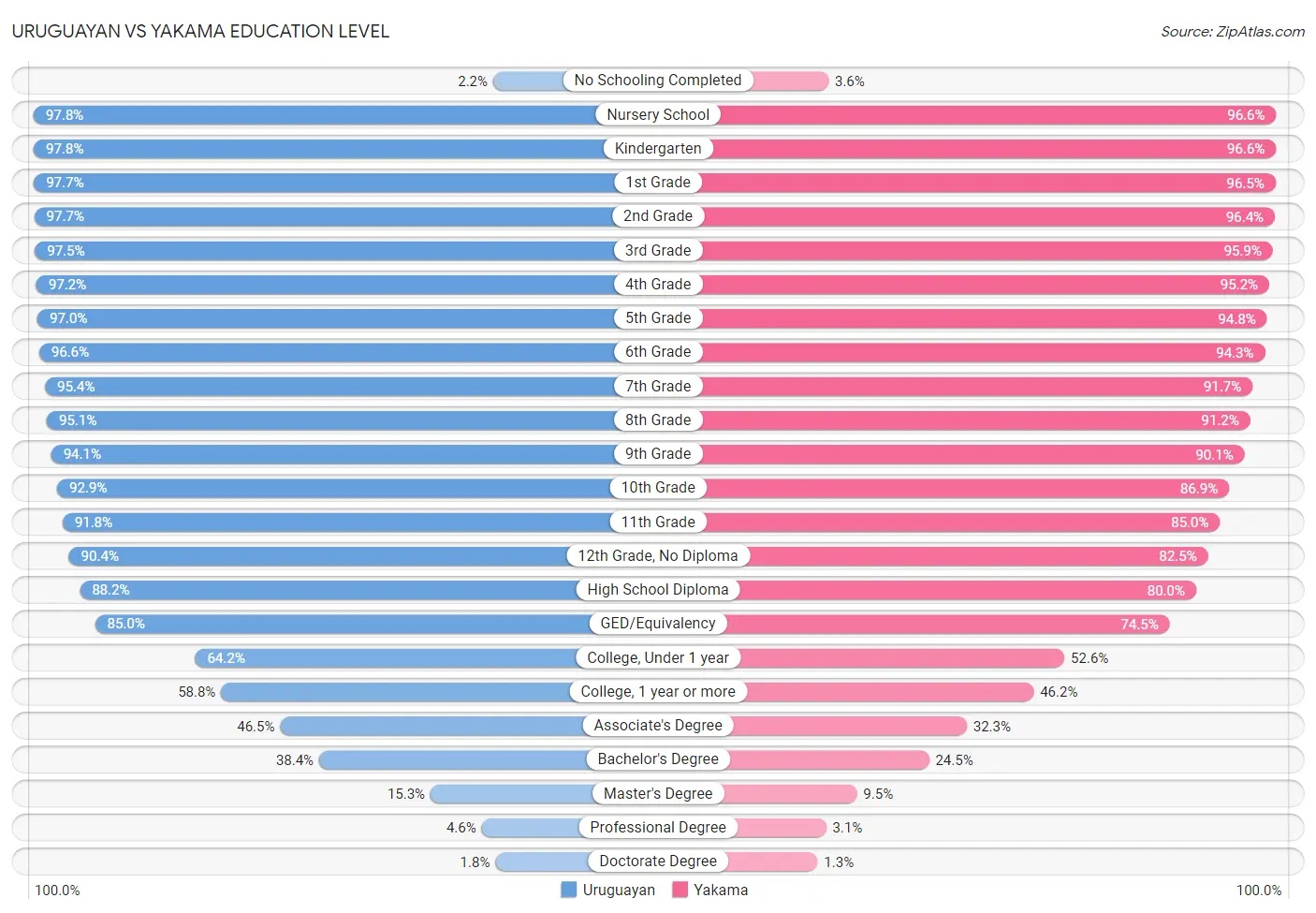
| Education Level Metric | Uruguayan | Yakama |
| No Schooling Completed | Poor 2.2% | Tragic 3.6% |
| Nursery School | Tragic 97.8% | Tragic 96.6% |
| Kindergarten | Tragic 97.8% | Tragic 96.6% |
| 1st Grade | Tragic 97.7% | Tragic 96.5% |
| 2nd Grade | Tragic 97.7% | Tragic 96.4% |
| 3rd Grade | Tragic 97.5% | Tragic 95.9% |
| 4th Grade | Tragic 97.2% | Tragic 95.2% |
| 5th Grade | Tragic 97.0% | Tragic 94.8% |
| 6th Grade | Tragic 96.6% | Tragic 94.3% |
| 7th Grade | Tragic 95.4% | Tragic 91.7% |
| 8th Grade | Tragic 95.1% | Tragic 91.2% |
| 9th Grade | Tragic 94.1% | Tragic 90.1% |
| 10th Grade | Tragic 92.9% | Tragic 86.9% |
| 11th Grade | Tragic 91.8% | Tragic 85.0% |
| 12th Grade, No Diploma | Tragic 90.4% | Tragic 82.5% |
| High School Diploma | Tragic 88.2% | Tragic 80.0% |
| GED/Equivalency | Poor 85.0% | Tragic 74.5% |
| College, Under 1 year | Poor 64.2% | Tragic 52.6% |
| College, 1 year or more | Fair 58.8% | Tragic 46.2% |
| Associate's Degree | Average 46.5% | Tragic 32.3% |
| Bachelor's Degree | Good 38.4% | Tragic 24.5% |
| Master's Degree | Good 15.3% | Tragic 9.5% |
| Professional Degree | Excellent 4.6% | Tragic 3.1% |
| Doctorate Degree | Fair 1.8% | Tragic 1.3% |
Uruguayan vs Yakama Disability
When considering disability, the most significant differences between Uruguayan and Yakama communities in the United States are seen in disability age 18 to 34 (6.2% compared to 9.0%, a difference of 45.0%), hearing disability (2.8% compared to 3.9%, a difference of 42.3%), and disability age 65 to 74 (22.2% compared to 29.6%, a difference of 33.4%). Conversely, both communities are more comparable in terms of cognitive disability (16.8% compared to 18.1%, a difference of 7.5%), disability age over 75 (46.2% compared to 51.3%, a difference of 10.9%), and self-care disability (2.4% compared to 2.7%, a difference of 11.7%).
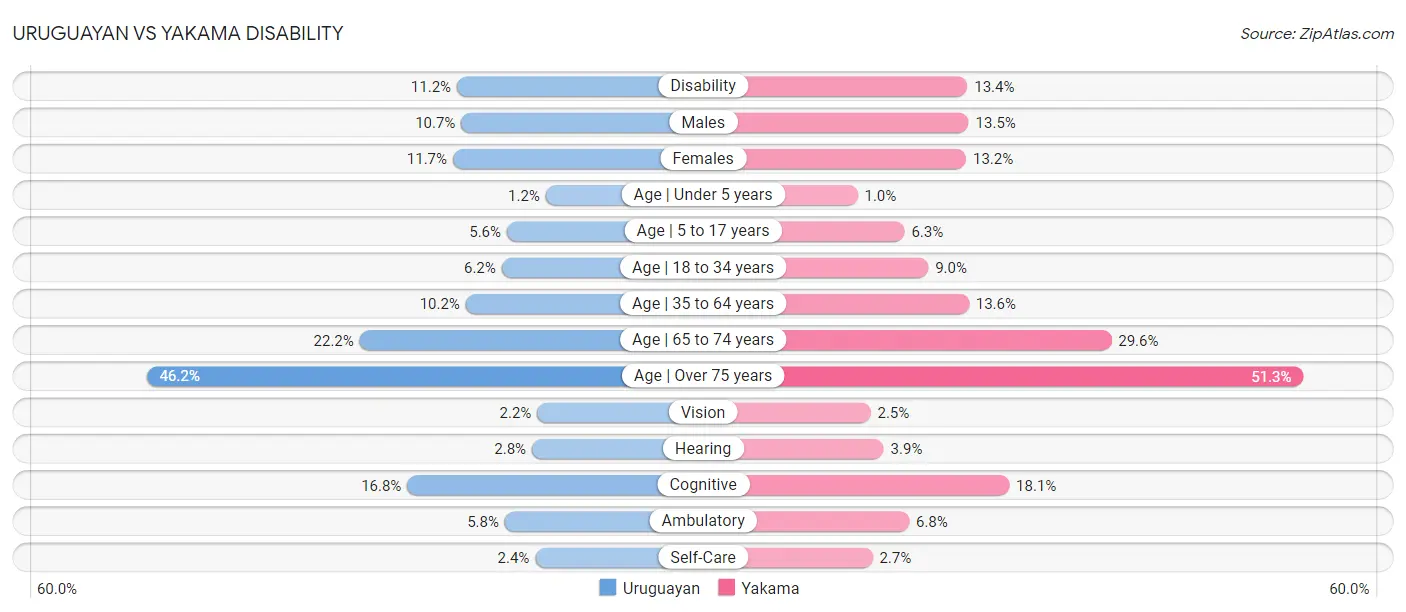
| Disability Metric | Uruguayan | Yakama |
| Disability | Exceptional 11.2% | Tragic 13.4% |
| Males | Exceptional 10.7% | Tragic 13.5% |
| Females | Exceptional 11.7% | Tragic 13.2% |
| Age | Under 5 years | Good 1.2% | Exceptional 1.00% |
| Age | 5 to 17 years | Average 5.6% | Tragic 6.3% |
| Age | 18 to 34 years | Exceptional 6.2% | Tragic 9.0% |
| Age | 35 to 64 years | Exceptional 10.2% | Tragic 13.6% |
| Age | 65 to 74 years | Exceptional 22.2% | Tragic 29.6% |
| Age | Over 75 years | Exceptional 46.2% | Tragic 51.3% |
| Vision | Average 2.2% | Tragic 2.5% |
| Hearing | Exceptional 2.8% | Tragic 3.9% |
| Cognitive | Exceptional 16.8% | Tragic 18.1% |
| Ambulatory | Exceptional 5.8% | Tragic 6.8% |
| Self-Care | Exceptional 2.4% | Tragic 2.7% |